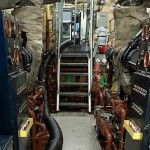As more and more information is finding its way onto the Web, great swaths of our physical infrastructure are becoming obsolete.
When we attempt to understand the implications of the Internet Age, the first thing we need to do is recognize that office buildings, retail stores, air travel, lecture halls, and paper are just clunky, expensive, and low-bandwidth interconnections.
Allow me to explain. Many things that seem as solid as the Rock of Gibraltar are, in fact, information proxies in disguise. We can view these information proxies as two separate pieces: an information-sensitive piece, and a second piece with a valuable function that cannot be displaced by better virtual environments.The Internet peels away the information-carrying portions of these physical things and institutions. Frequently it leaves behind skeletons of little value. In the process, the Internet restructures and renders much of our physical infrastructure obsolete.
For example, there are lots of reasons to go to a retail store. The shopper may go to a clothing store because he enjoys the experience of looking at the merchandise. He might want to find out what is available and how much it will cost, or feel the material, or leave the store with a suit he can wear the next day. Many, but not all, of the reasons he went shopping were to gather important information, yet there’s a lot of infrastructure associated with delivering that data. There’s the store itself and the shelving and display cases piled high with merchandise; employees to answer questions and operate the cash register; logistics systems and delivery trucks that carry merchandise to the store. Then there are the costs of keeping the stores lit, cool in the summer, warm in the winter, and clean at all times. Of course, the customer could not avail himself of all these information services without getting in a car, driving to the store, parking it in a garage, and buying gas.
Most of that information can be obtained without the car, without the shelving, without the employees. One of the reasons online retailing has been so effective is that it reduces many of these infrastructure costs while delivering the information the customer needs about price, availability, and size. Retailers engaged in the sale of commodities like books, CDs, blue jeans, and running shoes will find it increasingly difficult in the face of Internet competition. Some will be spared — the stores where customers really do want to see and feel the goods, and leave with them right away. (Upscale boutiques, for example, where the shopping experience is paramount, will be affected less.)
It’s not just retailers who will be transformed by the unbundling of information dissemination from physical locations. The need and function of places that support/reinforce interconnectedness will similarly diminish and change. An office building is both an information warehouse and an information exchange. In the future, the most important function it will perform is to provide a comfortable and productive location for face-to-face interaction. With more of us carrying our file cabinets in our laptops, cramming our overloaded out baskets into our PC’s and doing jobs for ourselves that administrative assistants used to do, the office of the past will probably become a warren of comfortable meeting rooms surrounded by temporary desks for those who choose to come to work that day. Those laptops will become smaller and lighter as files and applications move into the cloud.
In the case of a university, it is relatively easy to see the large-lecture classes, a strictly information-carrying portion of the educational process, being displaced by virtual courses. The university of the future will probably focus much of its energy on mentoring, small seminars, and guiding student laboratory and research experiences. A university where the vast proportion of the educational process focuses strictly on transferring information could well melt into virtual space.
The future will look very different as we strip the information-carrying functions out of proxies and reduce them to their bare essentials. Entertainment centers will be redefined. Libraries will take on new charters. Educational institutions will be restructured. Cities will be transformed. This will happen because much of our physical infrastructure was just a low-bandwidth interconnection disguised as something real.
– To the original… ➡
